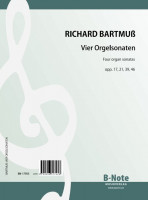€12.80 *
Prices incl. VAT plus shipping costs
On stock. Delivery time appr. 1-3 workdays (Germany). Also Available as instant download. PLEASE NOTE: You must create a customer account to purchase digital items; this is not possible as a guest customer.
Temporary suspension of deliveries to the USA
Dear customers, DHL has suspended shipping goods to the United States due to new customs regulations. As a result, we are temporarily unable to deliver to the United States. We apologise for any inconvenience this may cause. More information ...
Dear customers, DHL has suspended shipping goods to the United States due to new customs regulations. As a result, we are temporarily unable to deliver to the United States. We apologise for any inconvenience this may cause. More information ...
- Order number: BN-17926
- ISMN / ISBN 9790206517150
- Manufacturer B-Note Musikverlag, Wersaber Helmer 15, D-27628 Hagen i. Br. | post@bnote.de
Related links to
You viewed previously





























